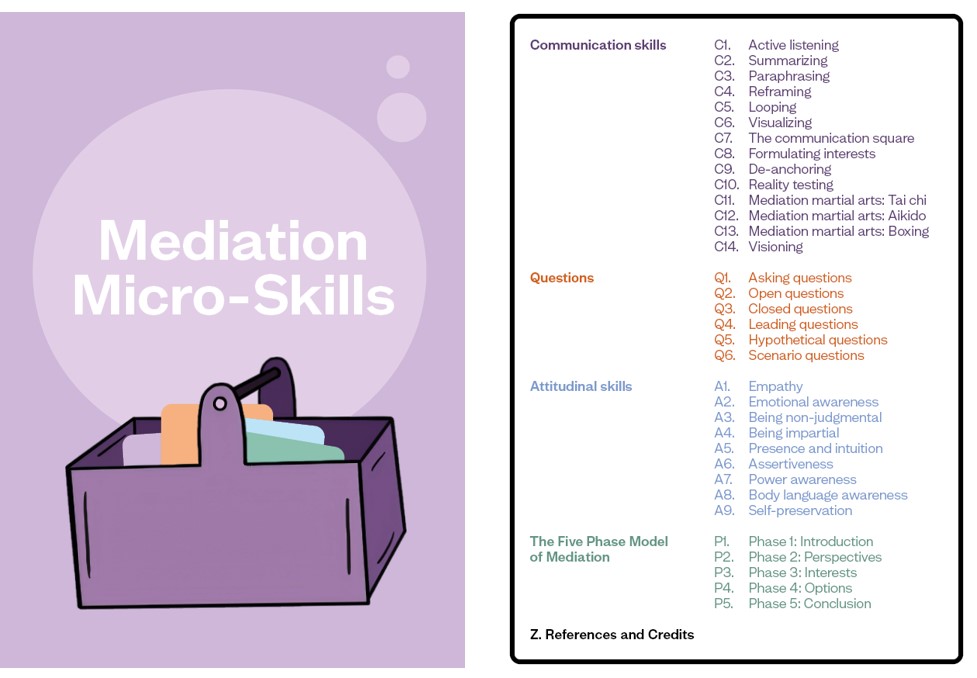Visualizing Mediation Micro-Skills
Mediation Micro-Skills – Card Deck
The MAS ETH MPP program, in consultation with relevant experts, has developed Download a deck of 34 cards (PDF, 3.5 MB), each representing an individual micro-skill, particularly relevant for peace mediation. The deck includes 14 communication skills, 6 types of questions, 9 attitudinal skills and 5 cards representing the Five Phase Model of Mediation (a card for each phase). Each card includes a unique graphic on the front and a definition and examples on the back.
Feel free to use them for learning, training, or mediation related purposes!
If you are interested in getting a hard copy of the deck of cards (CHF 20 per deck to cover the printing costs), please get in touch with the MAS ETH MPP program at to discuss further.

The Five Phase Model of Mediation – An Animated Overview
The Five Phase Model of Mediation offers a simple and systematic way of structuring a mediation process. Each phase is essential and there is a logic to its sequencing: (1) Introduction, (2) sharing perspectives to reach an agenda, (3) identifying underlying interests, (4) creating and assessing relevant options for resolution, and (5) concluding. Internalising this logic – as both a skill and a mindset – will help mediation practitioners implement it intuitively, adapting to context, and in one’s unique personal style.
This video illustration introduces the five phase model of mediation:
The video is accessible also in the following languages:
- Arabic: external page نموذج المراحل الخمس للوساطة: لمحة عامة
- Chinese: external page 调解五阶段模型概述
- English: external page The Five Phase Model of Mediation - An Animated Overview
- French: external page Le modèle de médiation en cinq phases : Un aperçu
- German: external page Das Fünf-Phasen-Modell der Mediation - Ein Überblick
- Russian: external page Пятифазная модель медиации: обзор
- Spanish: external page El Modelo de Mediación de Cinco Fases: una descripción general
Be a “Fly on The Wall” of a Mediation: Enacted Documentaries Showcasing the Five Phase Model of Mediation
In these two enacted documentaries, you will find examples of two mediation processes that also follow the Five Phase Model of Mediation (see animation video above for more details on the model). Zaza Elsheikh (external page BIMA) mediates a simulated conflict between two neighbors, while Christopher Moore (external page CDR Associates) mediates a simulated conflict between a mining company and local community representative.
Conflict parties in both enacted documentaries are played by professional actors: Beverley Worboys and JC Williams.
Enacted Documentary 1: Neighborhood dispute
Mediator: Zaza Elsheikh
Conflict context: Charlotte's family has moved into the neighborhood where Francis has lived his entire life. Every Sunday, Charlotte and her family have a lunch event with many guests. One month ago, Francis sent a note to his new neighbors explaining the local regulations with regards to noise and asking them to stop their noisy gatherings. With nothing changing the following Sundays, Francis contacted the municipality who suggested mediation before taking this any further.
This video includes Download graphic annotations (PDF, 881 KB) marking phase related content, micro skills and other important information.
See Download this document (PDF, 110 KB) for suggestions on how to use the enacted documentaries in teaching.
Enacted Documentary 2: Community-Company dispute
Mediator: Christopher Moore
Conflict context: One year ago, a foreign mining company was given permission by the state to start an excavation in a region rich in resources. This happened without the consent of the local community, who was afraid that their traditional rights to the use of the land will be ignored. Worried about all profits going abroad, the community also demanded employment opportunities at the mine. While the local communities held a march against the company, protesters clashed with the police and one protester was killed by a tear-gas grenade, heightening tensions. Efforts by the government to facilitate a dialogue between the company and the community failed and the state has therefore turned to the help of a professional mediator.
See Download this document (PDF, 110 KB) for suggestions on how to use the enacted documentaries in teaching.
Interviews with expert mediators Zaza Elsheikh and Christopher Moore
In these short video snippets, Zaza Elsheikh (external page BIMA) and Christopher Moore (external page CDR Associates) exemplify the use of micro-skills (for example, how to summarize, reframe, or respond to attacks) answer questions about micro-skills (such as what questions do you use most frequently? And are there questions you would never ask?), about attitudinal skills (such as how do you show empathy? What do you notice about body language? And what do you do for self-care?) and about mediation in general (for example, is it an art or a science? What are your “red lines” or what conflict would you not agree to mediate? And what are your tips for young mediators?).
See titles and links to all videos by Zaza Elsheikh external page here and by Christopher Moore external page here